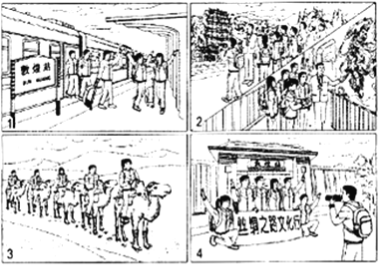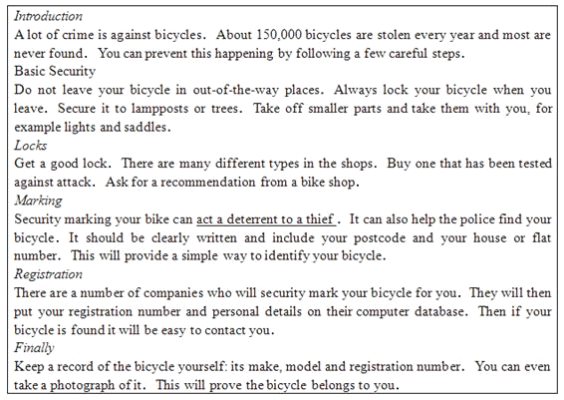ƒøƒ⁄»ð
°æƒø°øºŸ∂®”¢”ÔøŒ…œ¿œ ¶“™«ÛÕ¨◊¿÷ƺ‰Ωªªª–Þ∏ƒ◊˜Œƒ£¨«Îƒ„–Þ∏ƒƒ„Õ¨◊¿–¥µƒ“‘œ¬◊˜Œƒ°£
Œƒ÷–π≤”–10¥¶”Ô—‘¥ÌŒÛ£¨√øæ‰÷–◊Ó∂ý”–¡Ω¥¶°£√ø¥¶¥ÌŒÛΩˆ…ʺ∞“ª∏ˆµ•¥ µƒ‘ˆº”°¢…æ≥˝ªÚ–Þ∏ƒ°£
‘ˆº”£∫‘⁄»±¥ ¥¶º”“ª∏ˆ¬©◊÷∑˚∫≈£®![]() £©£¨≤¢‘⁄∆‰œ¬√Ê–¥≥ˆ∏√º”µƒ¥ °£
£©£¨≤¢‘⁄∆‰œ¬√Ê–¥≥ˆ∏√º”µƒ¥ °£
…æ≥˝£∫∞—∂ý”ýµƒ¥ ”√–±œþ£®![]() £©ªÆµÙ°£
£©ªÆµÙ°£
–Þ∏ƒ£∫‘⁄¥Ìµƒ¥ œ¬ªÆ“ª∫·œþ£¨≤¢‘⁄∏√¥ œ¬√Ê–¥≥ˆ–Þ∏ƒ∫Ûµƒ¥ °£
◊¢“‚£∫1.√ø¥¶¥ÌŒÛº∞∆‰–Þ∏ƒæ˘ΩˆœÞ“ª¥ £ª
2.÷ª‘ –Ì–Þ∏ƒ10¥¶£¨∂ý’þ£®¥”µ⁄11¥¶∆£©≤ªº∆∑÷°£
I have recently been told that listen to loud music is gradually making people hard of hearing. I'm sure it has already been happened to my neighbor. For years she had turned a deaf ear to my requests to turn her radio down. When she gives a party she doesn°Øt have to invite a rest of the street. Everyone can dance in her music in his own room. Now a scientist has discovered certain electronic sounds have strangely effects on rats. He declares break down, almost paralyze(ñ) with their legs trembled. Then it is simply a matter of throwing them out by their tail. I wonder that the same thing will happen to my neighbor someday.
°æ¥∞∏°ø1.listen°™listening
2. »•µÙbeen
3.had---has
4. a---the
5. in---to
6.strangely ---strange
7. declares∫Ûº”they
8. trembled---trembling
9. tail---tails
10.that---if/whether
°æΩ‚Œˆ°ø
±æŒƒ «“ª∆™º«–Œƒ£¨◊˜’þµƒ¡⁄æ”∑«≥£œ≤ª∂Ã˝≥≥ƒ÷µƒ“Ù¿÷£¨◊˜’þ»œŒ™’‚÷÷œ∞πþ“—æ≠∂‘À˚≤˙…˙¡À≤ª∫√µƒ”∞œÏ°£Õ¨ ±◊˜’þªπΩȅСÀ‘⁄¿œ Û…Ì…œΩ¯––µƒ“ªœÓ µ—È°£
µ⁄“ª¥¶£∫øº≤È∂Ø√˚¥ ”√∑®°£±ææ‰÷–∂Ø√˚¥ ∂Ôԑ⁄æ‰÷–◊ˆ÷˜”Ô£¨±Ì ææ≠≥£–‘œ∞πþ–‘µƒ––Œ™°£æ‰“‚£∫◊ÓΩ¸Œ“±ª∏Ê÷™Ã˝≥≥ƒ÷µƒ“Ù¿÷ª·Ω•Ω•µÿ»√»À√«Ã˝≤ªº˚°£
µ⁄∂˛¥¶£∫øº≤È”Ôè°£∂Ø¥ happen“‚Œ™°∞∑¢…˙°¢≈ˆ«…°±£¨√ª”–±ª∂Ø”Ô谣打‚£∫Œ“»∑–≈’‚º˛ ¬«È“ªæ‰∑¢…˙‘⁄Œ“µƒ¡⁄æ”…Ì…œ°£
µ⁄»˝¥¶£∫øº≤È ±Ã¨°£ ±º‰◊¥”Ôfor yearsÕ®≥£“™∫Õœ÷‘⁄ÕÍ≥… ±¡¨”√£¨À˘“‘±ææ‰ π”√œ÷‘⁄ÕÍ≥… ±has turned°≠°£æ‰“‚£∫º∏ƒÍ“‘¿¥À˝∂‘Œ““™«Ûµ˜µÕ ’“Ùª˙µƒ“™«Û≥‰∂˙≤ªŒ≈°£
µ⁄Àƒ¥¶£∫øº≤Èπ⁄¥ °£∂ÔÔthe rest of°≠.°∞∆‰”ýµƒ°≠°±æ‰“‚£∫µ±À˝æŸ––怪·µƒ ±∫Ú£¨À˝≤ªµ√≤ª—˚«ÎΩ÷…œµƒ∆‰À˚»À°£
µ⁄ŒÂ¥¶£∫øº≤ÈπÃ∂®∂Ô԰£∂ÔÔdance to the musicÀÊ◊≈“Ù¿÷ïŒË°£æ‰“‚£∫√ø∏ˆ»À∂ºø…“‘‘⁄À˚µƒ∑øº‰¿ÔÀÊ◊≈“Ù¿÷ïŒË°£
µ⁄¡˘¥¶£∫øº≤È–Œ»ð¥ °£‘⁄”¢”Ô÷––Œ»ð¥ Õ®≥£◊ˆ∂®”ÔªÚ’þ±Ì”Ô£¨∏±¥ Õ®≥£◊ˆ◊¥”Ô£ª±ææ‰÷––Œ»ð¥ strange◊ˆ∂®”Ô–Þ Œ√˚¥ effects°£
µ⁄∆þ¥¶£∫øº≤Èæ‰◊”Ω·ππ°£∂Ø¥ declare∫Û√ÊΩ”±ˆ”Ô¥”扣¨¥”æ‰÷–»±…Ÿ÷˜”Ô£¨”√they÷∏¥˙«∞æ‰÷–µƒrats°£æ‰“‚£∫À˚…˘≥∆À˚√«±¿¿£¡À°£
µ⁄∞À¥¶£∫øº≤È∑«ŒΩ”Ô∂Ø¥ °£±ææ‰÷–∫¨”–“ª∏ˆ°∞with∏¥∫œΩ·ππ°±£¨∆‰÷–ΩÈ¥ withµƒ±ˆ”Ôtheir legs”Î∂Ø¥ trembleππ≥…÷˜∂Øπÿœµ£¨À˘“‘ π”√œ÷‘⁄∑÷¥ trembling‘⁄æ‰÷–◊ˆ±ˆ”Ô≤π◊„”Ô°£
µ⁄æ≈¥¶£∫øº≤È√˚¥ µ•∏¥ ˝°£±ææ‰÷–their÷∏¥˙…œæ‰÷–µƒrats£¨À˘“‘“™ π”√∏¥ ˝–Œ Ωtails°£
µ⁄ Æ¥¶£∫øº≤ȱˆ”Ô¥”扡¨Ω”¥ °£æ‰“‚£∫Œ“œÎ÷™µ¿Õ¨—˘µƒ ¬«È «∑Ò“≤ª·∑¢…˙‘⁄Œ“µƒ¡⁄æ”…Ì…œ°£



